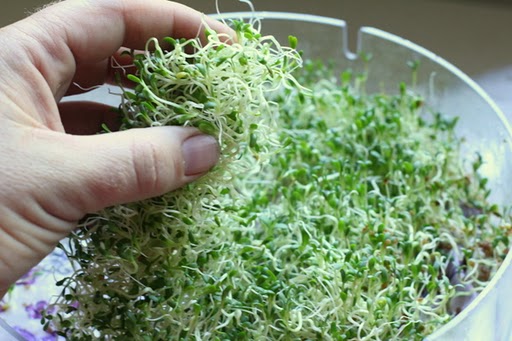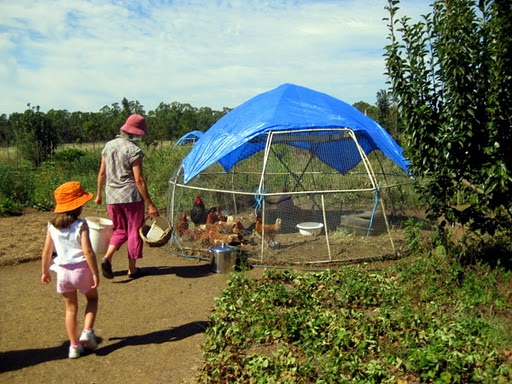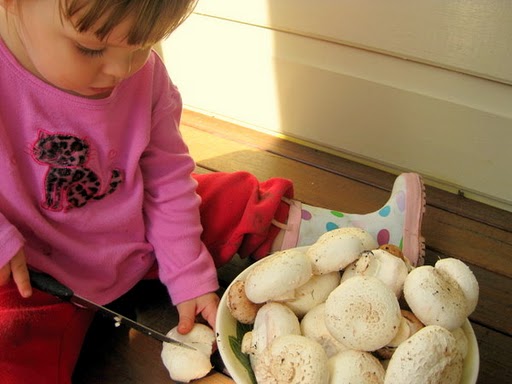4 Fun Tips for Encouraging Children to Eat Vegetables
When I serve my daughter vegetables on a plate, more often than not she’ll turn her nose up in distaste and claim that she doesn’t like vegetables. Thankfully I’ve noticed there are certain situations when she’ll happily eat all her vegetables. For example, if I sit her on a bench next to a jar of fresh sprouts, or help her harvest veggies from our garden, she’ll gobble them up in no time at all!
It seems there’s something about being ‘involved’ in the growing or selection of vegetables that makes them more appealing to children. I thought I’d share four tips that encourage my daughter to eat her vegetables. Perhaps what works for my child will work for yours also?
1. Grow food on the kitchen bench
Growing sprouts or microgreens on the kitchen bench makes it easy for children to be involved in growing their own food. Growing sprouts is quick and simple, with many being ready to eat in only a few days. My daughter especially loves crunchy Mung Bean and Pea sprouts.
2. Set up a backyard vegetable garden
If you have the space, a backyard vegetable garden is a great way to help your child connect with nature, and their food. Plant some quick growing vegetables, like radishes, lettuce, and sunflowers so they don’t lose interest.
Vegetables that can be eaten straight from the garden, like cherry tomatoes, peas, beans and corn, are also great gardening choices for children. My daughter will often wander through the garden picking and eating cherry tomatoes, beans, and even herbs. A freshly picked, sun-warmed home-grown tomato is far tastier than a hard cold supermarket one.
3. Make shopping an experience rather than a chore
A visit to the farmers market, or to a local farm to pick your own vegetables, is so much fun for children, and much more exciting than the grocery store. Let them choose the vegetables. Stop and chat to a farmer. If those carrots you’re cooking for dinner come with a story, your child is more likely to eat them. Our local farmers market even has face-painting, pony rides, and bouncy castles, so thankfully our weekly visit to the farmers market is seen as a treat rather than a chore.
4. Involve children in the kitchen
Cooking with your children gets them involved in the process and they’re more likely to eat something they’ve been involved in creating. Of course, letting them help means more time and more mess, but the benefits far outweigh the hassles. Learning to cook is a skill your children can use for the rest of their lives and can also help build self-confidence.
Even very young children can safely help. They can wash vegetables, mash, mix and measure.
And if your child still rejects vegetables after all these experiences?
No problem. You’ve probably heard that children need to be exposed to a food 10, 20 or 50 times before they develop a taste for them. Each of the above experiences count as an exposure. Growing, gardening, watching, choosing, picking, chopping, and cooking, all take your child one step closer to loving vegetables.
“Don’t force vegetables down their throat. Get the children involved and you’ll be surprised how quickly they grow to accept vegetables in their diet,”
– Mr Churchill, AUSVEG
Do you have any helpful tips for encouraging children to love vegetables? I’d love to hear them.







All these tips really work! I’d like to add a bit about cooking – if your child is mesmerized by gadgets, then definitely offer him kitchen gadgets to use while cooking (with close supervision, of course). My son absolutely hated eggs until a couple of weeks ago I showed him how to use an egg slicer. He now loves eggs if he gets to slice them. Same with vegetables – he was absolutely anti-veggie kind of guy until we got our old juice-maker out. Now he can’t get enough of carrots, beets and celery (in juice form, but better than nothing, right?).
Thanks Yelena. You’ve reminded me to get out the apply slinky machine and slink a few vegetables. My daughter also loves carrot and celery juice with a little apple.
These are all fantastic ideas. I find my daughter is much more likely to eat veg in their natural state – raw, as finger food, rather than cooked or “hidden” in meals. In fact we actually encourage her to “play with” her food when it comes to veg. If she peels open a green bean to see the “baby beans” inside, or pretends to be a baby giraffe munching on a broccoli “tree”, she seems to eat them happily.
We’re playing with food fans here also. It’s amazing what a difference a little creative play can make at diner time. Thanks for sharing Maggie.
We’ve recently put in a veggie patch and I have found that I have to work really hard to make the kids wait until the fruit and vegetables have ripened before they rip into them! I’ve also discovered that serving up a communal plate of vegetables or salad which the kids can pick from, versus serving it up on their own individual plates has them much more enthusiastic about eating their greens. By the way, broccoli = “tree” in our house too : )
I like the communal plate idea Melissa. We often share a big plate of bean nachos with plenty of salad. You’re right about it making children much more enthusiastic. I hope your veggie patch is going well.
Call the dishes interesting things, like Magic Triangles (vege filled emapanadas), or make Vege fritters in the shape of letters of their names, works well with our fussy kids!
My boys are definitely more likely to eat their veggies if they have grown or picked them themselves. I just need to find time to grown a few more things. Strawberries are always a hit but sugar snap peas and snow peas were popular for grazing on last spring and Junior loves to eat the potatoes he dug in grandpa’s garden.
This is a fabulous article. I have been a nanny for ten years and a preschool teacher for three. Across the board, with all the children I have worked with, involvement in any food preparation process, and I’m talking about involvement that goes as far back in the process as possible (including gardening) incites so much excitement about the food. As adults, we have become separated from the source of our food and we certainly see how much it changes what we eat. As we empower our children around food choices, we also become more empowered and involved. It’s definitely a win-win.
I think getting children involved in growing their food, preparing and cooking it is such a great way to teach them about healthy eating. My daughter has always helped ‘wash the veggies’, even when she was in her highchair and the benefit is that she often eats them! Now at nearly 4 she loves eating raw vegatables and we often don’t even cook them for her.
We have always had much more success when our little one helps me prepare dinner. She will snack on the veg as we cook.
It is definitely true that if you empower your children to make their own choices, you have a much better chance of getting them to eat the right kinds of foods. For anyone reading who has a truly fussy eater, try looking at HealthyChart.com.au, a magnetic incentive chart that helps kids get a balanced diet, plenty of water and lots of exercise.
Great post! I am hoping that starting our CSA in the spring will help to spark Elle’s interest in veggies again.
Great post!